Most people think bench pressing is simple—just lie down, grab the bar, and start pushing, right?
Wrong.
Proper bench press form is more intricate than it looks, and even minor mistakes in your setup and execution can limit your progress or, worse, cause injury.
In this expert guide, you’ll learn how to bench press with perfect technique.
You’ll also discover how to warm up for the bench press, understand the intricacies of bench press grip, learn how to instantly improve your bench press performance, and more.
How to Perform Proper Bench Press Form
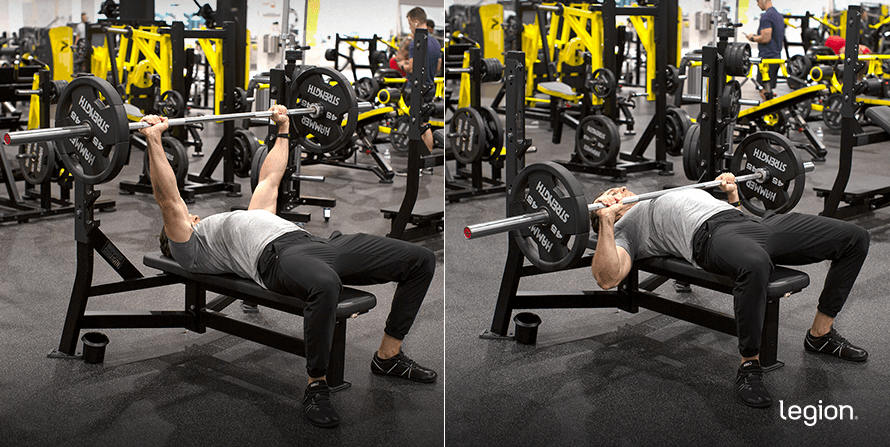
To learn how to bench press, split the exercise into three parts: set up, descend, and press.
1. Set Up
Place a barbell in the hooks of a bench press station, then lie on the bench so your eyes are directly under the bar.
Place your feet on the floor about shoulder-width apart and directly under your knees.
Arch your back by pushing your chest toward the bar (while keeping your shoulders and butt on the bench), then pull your shoulder blades together and toward your butt (imagine you’re “putting your shoulder blades into your back pockets”) like this:
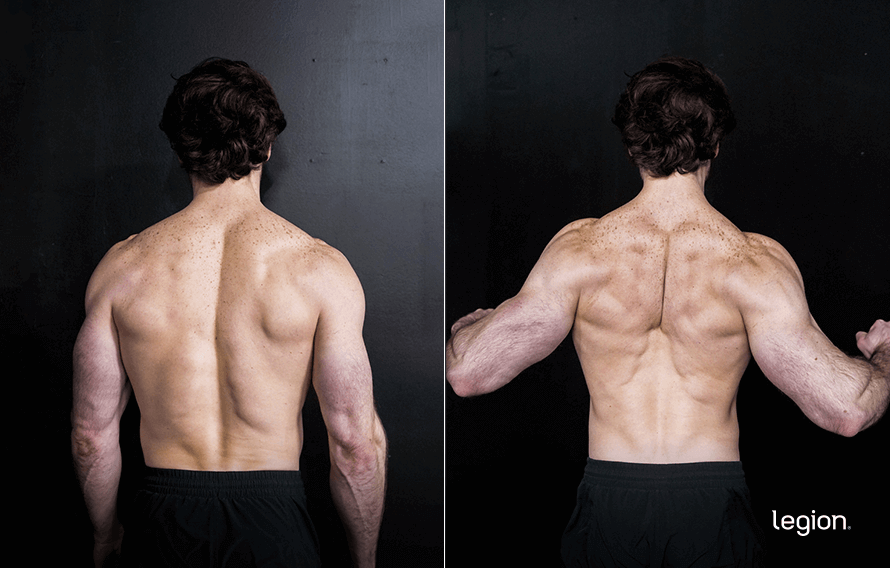
Bench Press Grip
Many people overlook the finer details of a proper bench press grip, yet it’s a crucial part of your setup. Let’s break down the most important aspects to help you grip the bar correctly:
- Bench Press Grip Width: Many weightlifters tinker with their grip width on the bench press, thinking it’ll subtly change which muscles you train. In reality, it makes little difference. The best approach is a medium grip, around 18-to-24 inches wide, as it’s typically the most comfortable and stable for lifting heavy weights safely.
- Bench Press Wrist Position: Wrist position for the bench press matters more than most realize—get it wrong, and you’ll “leak” force that should be helping lift the bar. To avoid this, bend your wrists back slightly, letting the bar rest in the base of your palms without allowing them to fold back at sharp angles.

- How to Grip the Bar: Wrap your fingers and thumbs around the bar and squeeze it as tightly as you can. This grip prevents the bar from slipping out of your hands and also boosts performance.
2. Descend
Lower the bar until it touches your chest in line with your nipples, keeping your elbows about 6-to-10 inches from your ribs.
3. Press
Push the bar up and return to the starting position, keeping your shoulder blades and elbows tucked.
When you’re on the last rep of a set of the flat barbell bench press, finish it fully (arms straight), and then slam the bar back into the upright metal bars, and lower it onto the hooks. Don’t try to press the bar directly back into the hooks because if you miss, it can fall on your face.
Here’s how it should look when you put it all together:
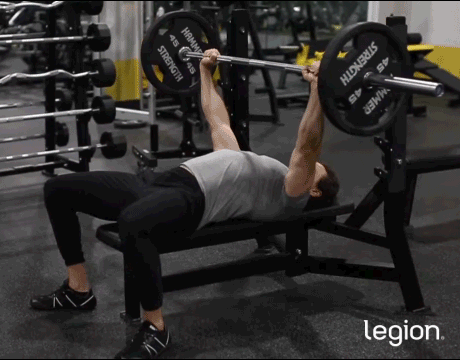
How to Warm Up for the Bench Press
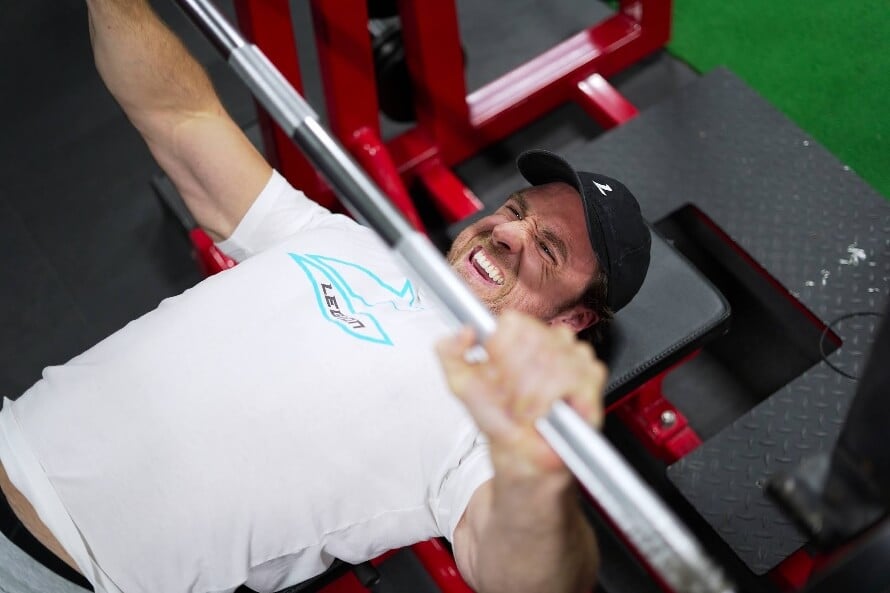
Working through a proper bench press warm up is vital for performing at your best. According to research, warming up with heavy weights is the best way to prime your body for your “hard” bench press sets.
Here’s the protocol I recommend:
- Roughly estimate what weight you’re going to use for the bench press in your first set (this is your “hard set” weight).
- Do 6 reps with about 50% of your hard set weight and rest for a minute.
- Do 4 reps with about 70% of your hard set weight and rest for a minute.
Then, begin your hard sets.
How to Improve Your Bench Press: 5 Quick Tips
Use the following five tips to instantly improve your bench press performance:
1. Use the Right Cues
The best cues for enhancing bench press performance are:
- “Touch your chest to the ceiling”: Trying to touch the ceiling with your chest keeps your shoulders back and down and spine arched and ensures your pecs do most of the work.
- “Screw your feet into the floor”: Imagining screwing your feet into the floor creates tension in your legs which increases stability, rigidity, and balance.
- “Rip the bar apart”: Thinking about ripping the barbell apart ensures your upper back remains engaged, providing a stable base to press off.
2. Use Leg Drive
Using your legs to “drive” your body up the bench as you press the weight benefits your performance in two ways:
- It increases lower-body stability
- It facilitates a more efficient bar path
Just remember, the point is not to push your hips up to the ceiling, but to slide your body toward the top of the bench. Here’s a diagram to help you visualize this:
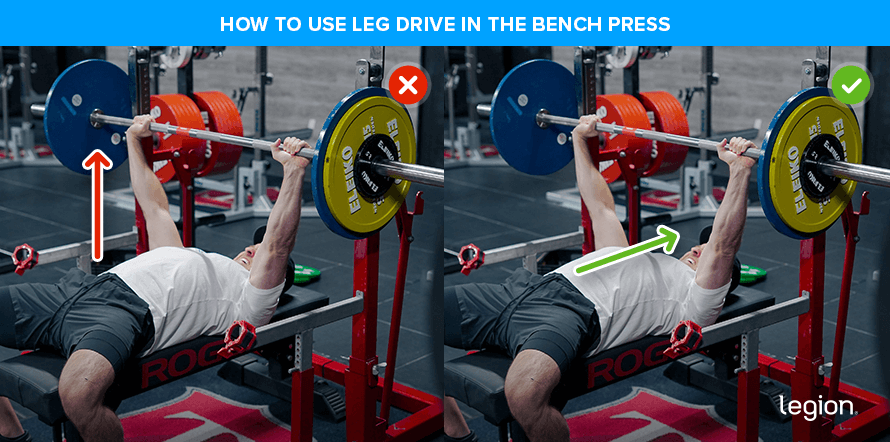
To learn more about how to maximize bench press leg drive, check out this article:
How to Use Leg Drive in the Bench Press to Build More Muscle
3. Squeeze the Bar
For an easy strength boost, grip the barbell as hard as you can, clench your jaw muscles, and push your tongue into the roof of your mouth. Several studies show that doing so boosts your strength and power production.
To learn more about this phenomenon, check out this article:
How to Use Remote Voluntary Contraction to Instantly Get Stronger
4. Use a Spotter
Having a spotter on the bench can increase the number of reps you can perform and make you feel more confident in your ability to complete each set successfully, which should aid performance over the long term.
5. Fix Your Bar Path
Research shows that many beginners struggle with an inefficient bench press bar path, often pressing the bar straight up and down.
This forces the front delts to work harder to stabilize the weight and limits how much weight you lift.
To press more efficiently:
- Start each rep with the bar directly over your shoulders.
- Lower the bar in a slight arc to your lower chest.
- Press the bar up and toward your throat.
- Finish with the bar directly over your shoulders.
Here’s how it should look:
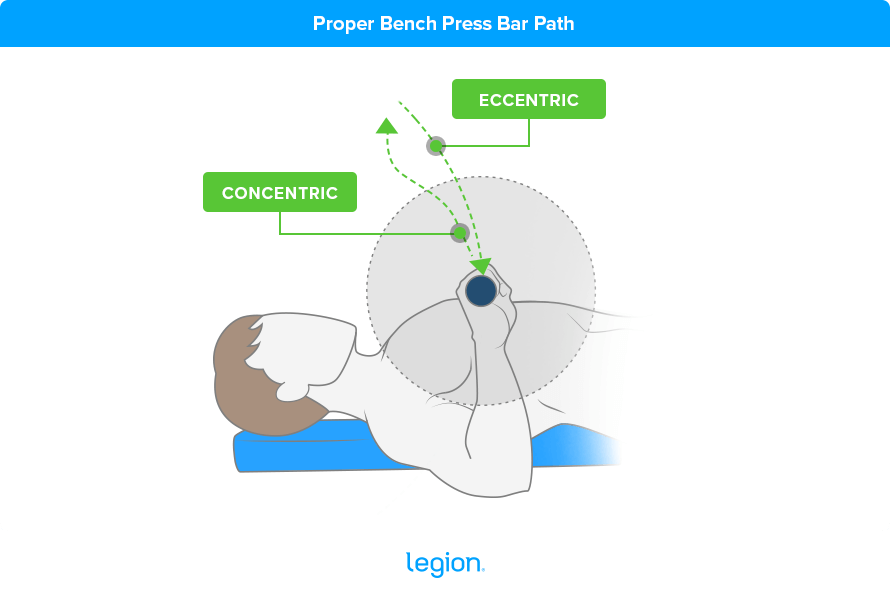
Benefits of the Bench Press
Upper Body Hypertrophy
The bench press primarily trains the pecs, shoulders and triceps, but it also engages almost every muscle group above the waist, which makes it extremely effective for gaining all-around upper body mass.
Strength Gain
The flat barbell bench press is exceptionally stable, so it allows you to lift maximally heavy weights safely.
It also enables you to increase the load you lift in small increments, so you can make steady, manageable progress without hitting plateaus or risking injury.
Enhanced Athletic Performance
Research shows that the bench press boosts upper body pushing power, making it ideal for athletes who need to throw, punch, jostle, or quickly get up off the ground in their sport.
Muscles Worked in the Bench Press
The main muscles worked in the bench press are:
- Pectorals
- Deltoids
- Triceps
Here’s how these muscles look on your body:
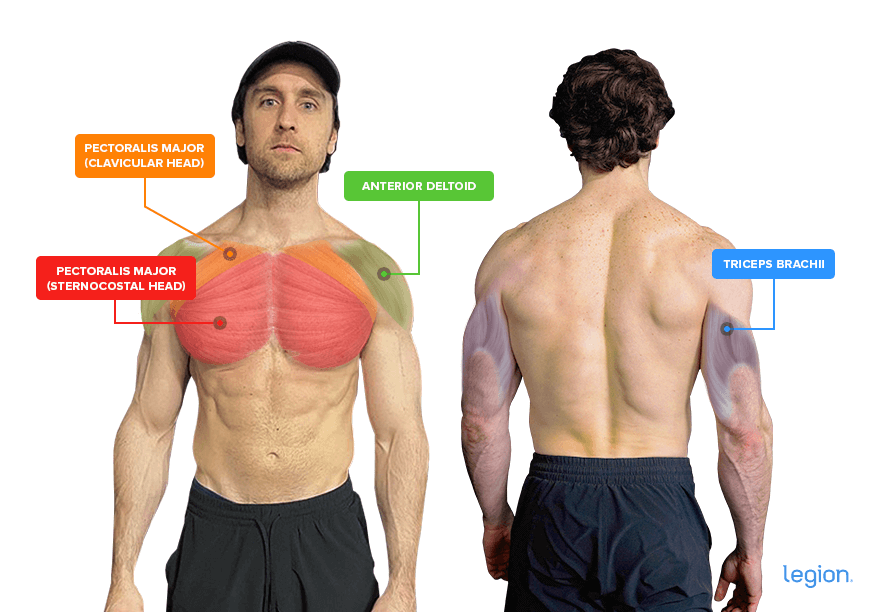
That said, the bench press engages many other muscles to a lesser degree. To find out which ones, check out this article:
What Muscles Does Bench Press Work? An Evidence-Based Guide
The Best Bench Press Variations
1. Close-Grip Barbell Bench Press
When you narrow your grip on the bar and keep your elbows close to your ribs, you place more of the load on the triceps and slightly less on your chest.
The close-grip bench press is just a regular bench press performed with your hands a few inches inside shoulder-width apart, or about 2-to-3 inches closer than your normal grip. Other than the grip modification, you should perform the close-grip bench in exactly the same way as the bench press.
2. Dumbbell Bench Press
The dumbbell bench press is similar to the barbell bench press, except you press one dumbbell in each hand instead of a barbell.
The two main benefits of the dumbbell bench press are that it allows you to increase the range of motion beyond the standard barbell bench press and to use whatever wrist position feels more comfortable to you.
3. Incline Barbell Bench Press
The incline bench press works exactly the same way as the barbell bench press, except you lie on an incline bench instead of a flat bench.
When doing the incline bench press, the angle of incline in the bench should be 30-to-45 degrees. The basic setup and movement of the incline bench press is just as you learned for the regular bench press, with a small exception: the bar should pass by the chin and touch just below the collarbones to allow for a vertical bar path.
4. Reverse-Grip Barbell Bench Press
The reverse-grip bench press is similar to the close-grip and incline bench press, in that it emphasizes the upper portion of your chest muscle.
To do the reverse-grip bench press, flip your grip around on the bar (so your palms face you). Grip the bar so that it crosses your palm diagonally, from the base of your index finger to the opposite edge of your wrist.
5. Decline Bench Press
The decline barbell bench press is popular among some people but I’m not a fan. Thanks to its reduced range of motion, it’s just less effective than incline and flat pressing.
A common argument made for doing decline presses is working the lowest portion of the pectoralis major, but there isn’t much evidence that you need to specifically train the “lower” portion of the pecs (which are already trained during the flat barbell bench press).
FAQ #1: Incline bench vs. Flat bench: What’s the difference?
The main difference between the incline and flat barbell bench press is that the incline version emphasizes your “upper chest,” whereas the flat bench trains the mid and lower pecs more.
Since these exercises complement each other, it’s a good idea to include both in your routine to develop a fuller, more balanced chest.
FAQ #2: Is the chest press the same as the bench press?
Not exactly. Both exercises train the same primary muscles—the pecs, front delts, and triceps—so the chest press is a viable alternative to the bench press.
That said, research also shows that free-weight barbell presses engage more stabilizer muscles than machine-based presses, which likely means that the flat barbell bench press is better for gaining all-around muscle than the chest press.
For example, a study published in The Journal of Strength and Conditioning found that the free-weight bench press was superior to the Smith machine bench press for training the side delts:
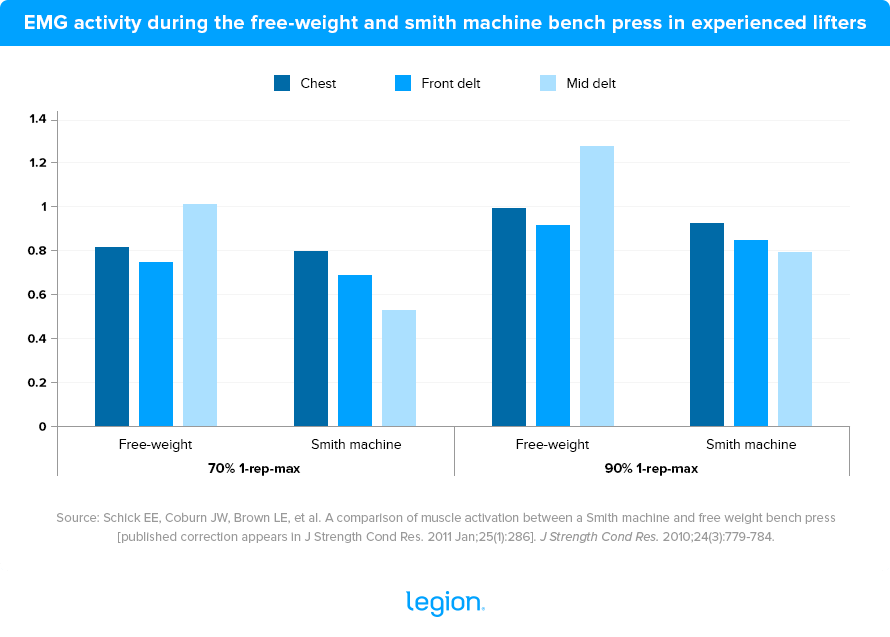
Thus, if you want to maximize overall muscle growth and build functional strength, the flat barbell bench press is your best option. And if you’re looking for a safe, straightforward exercise for gaining pec, shoulder, and triceps size, the chest press is highly effective.
FAQ #3: Why is my bench not improving?
If your bench press isn’t improving, the most likely culprit is poor form. A good way to burnish your technique is to spend extra time during your bench press warm-up grooving in proper form.
If your form is solid, the next most likely reason that your bench has stalled is that you aren’t benching enough.
Try increasing your bench frequency to 2 or 3 times a week, and make sure it’s the first exercise you do on bench days.
And if this doesn’t get you unstuck, check out this article for more advice on how to improve your bench press:
Increase Your Bench Press Max With 16 Science-Backed Techniques
FAQ #4: How much does a bench press bar weigh?
A standard bench press bar is an Olympic barbell, which weighs 45 pounds (20 kilograms).
For more information about the weights of different barbells, check out this article:
How Much Does a Barbell Weigh? A Comprehensive Guide
FAQ #5: Why do my arms hurt from bench press?
If your triceps feel sore after bench pressing, it’s likely just delayed onset muscle soreness (DOMS), which is a normal part of strength training.
However, if you feel sharp pain in your biceps or elbows, there may be an issue with your form.
Benching with an excessively wide grip can strain your biceps tendons, so narrowing your grip can ease biceps pain in some scenarios.
Additionally, flaring your elbows too far from your body can increase pressure on the long head of the biceps, especially during the lowering phase of the lift. To avoid this, tuck your elbows closer to your sides—6-to-10 inches from your ribs works well for most.
If elbow pain is the issue, check out this article for guidance on how to fix it:
Have Elbow Pain? This Is Your 4-Step Guide to Fixing It
FAQ #6: How do you bench with one arm longer than the other?
Many people feel like one of their arms is longer than the other during the bench press because one arm takes longer to “lock out” (fully straighten).
However, it’s usually not an issue of arm length—it’s more likely due to a strength imbalance. When one side of your body is weaker, it struggles more to finish each rep.
To correct this common issue, make sure you include unilateral exercises (exercises that train each side of your body independently) like the dumbbell bench press in your routine. This helps even out strength differences since your strong side can’t make up for your weaker side.
Also, pay attention to your setup. If your shoulders or grip is asymmetrical, it can create the illusion of one arm being longer while benching.
Scientific References +
- Saeterbakken, Atle Hole, et al. “The Effect of Grip Width on Muscle Strength and Electromyographic Activity in Bench Press among Novice- and Resistance-Trained Men.” International Journal of Environmental Research and Public Health, vol. 18, no. 12, 14 June 2021, p. 6444, https://doi.org/10.3390/ijerph18126444. Accessed 2 Sept. 2021.
- Mausehund, Lasse, et al. “Understanding Bench Press Biomechanics—the Necessity of Measuring Lateral Barbell Forces.” Journal of Strength and Conditioning Research, vol. Publish Ahead of Print, 4 Feb. 2021, https://doi.org/10.1519/jsc.0000000000003948.
- “Effect of Remote Voluntary Contractions on Isometric Prime Mover Torque and Electromyography.” ResearchGate, 2024, www.researchgate.net/publication/282724663_Effect_of_remote_voluntary_contractions_on_isometric_prime_mover_torque_and_electromyography. Accessed 1 Oct. 2024.
- Viveiros, Leonardo , et al. High-Load and Low-Volume Warm-up Increases Performance in a Resistance Training Session. 12 Aug. 2023, pp. p1487-1491, www.bodyworkmovementtherapies.com/article/S1360-8592(24)00401-7/abstract?ck_subscriber_id=1108414226, https://doi.org/10.1016/j.jbmt.2024.08.004.
- Ribeiro, Bruno, et al. “The Role of Specific Warm-up during Bench Press and Squat Exercises: A Novel Approach.” International Journal of Environmental Research and Public Health, vol. 17, no. 18, 22 Sept. 2020, p. 6882, https://doi.org/10.3390/ijerph17186882.
- Kristiansen, M., et al. “Inter-Subject Variability of Muscle Synergies during Bench Press in Power Lifters and Untrained Individuals.” Scandinavian Journal of Medicine & Science in Sports, vol. 25, no. 1, 24 Dec. 2013, pp. 89–97, https://doi.org/10.1111/sms.12167.
- Van Every, Derrick W., et al. “Biomechanical, Anthropometric and Psychological Determinants of Barbell Bench Press Strength.” Sports, vol. 10, no. 12, 5 Dec. 2022, p. 199, https://doi.org/10.3390/sports10120199.
- EBBEN, WILLIAM P., et al. “The Effect of Remote Voluntary Contractions on Knee Extensor Torque.” Medicine & Science in Sports & Exercise, vol. 40, no. 10, Oct. 2008, pp. 1805–1809, https://doi.org/10.1249/mss.0b013e31817dc4ad.
- Garceau, Luke R, et al. “Effect of Remote Voluntary Contractions on Upper Body Force and Muscle Activation in Women and Men.” Journal of Strength and Conditioning Research, vol. 24, Jan. 2010, p. 1, https://doi.org/10.1097/01.jsc.0000367113.51402.34.
- Sheridan, Andrew, et al. “Presence of Spotters Improves Bench Press Performance: A Deception Study.” Journal of Strength and Conditioning Research, vol. 33, no. 7, July 2019, pp. 1755–1761, research.edgehill.ac.uk/ws/portalfiles/portal/20211469/Sheridan+et+al+%28Accepted+Manuscript+JSCR-08-8664-R1%29.pdf, https://doi.org/10.1519/jsc.0000000000002285.
- Schoenfeld, Brad J. “The Mechanisms of Muscle Hypertrophy and Their Application to Resistance Training.” Journal of Strength and Conditioning Research, vol. 24, no. 10, Oct. 2010, pp. 2857–72.
- López-Laval, Isaac, et al. “Relationship between Bench Press Strength and Punch Performance in Male Professional Boxers.” Journal of Strength and Conditioning Research, Aug. 2019, p. 1, https://doi.org/10.1519/jsc.0000000000003362.
- “(PDF) Effects of Variations of the Bench Press Exercise on the EMG Activity of Five Shoulder Muscles.” ResearchGate, www.researchgate.net/publication/232217991_Effects_of_Variations_of_the_Bench_Press_Exercise_on_the_EMG_Activity_of_Five_Shoulder_Muscles. Accessed 28 May 2021.
- Trebs, Arthur A, et al. “An Electromyography Analysis of 3 Muscles Surrounding the Shoulder Joint during the Performance of a Chest Press Exercise at Several Angles.” Journal of Strength and Conditioning Research, vol. 24, no. 7, July 2010, pp. 1925–1930, insights.ovid.com/strength-conditioning-research/jscr/2010/07/000/electromyography-analysis-muscles-surrounding/31/00124278, https://doi.org/10.1519/jsc.0b013e3181ddfae7.
- Lauver, Jakob D., et al. “Influence of Bench Angle on Upper Extremity Muscular Activation during Bench Press Exercise.” European Journal of Sport Science, vol. 16, no. 3, 23 Mar. 2015, pp. 309–316, https://doi.org/10.1080/17461391.2015.1022605.
- “Effects of Variations of the Bench Press Exercise on The… : The Journal of Strength & Conditioning Research.” LWW, 2019, journals.lww.com/nsca-jscr/abstract/1995/11000/effects_of_variations_of_the_bench_press_exercise.3.aspx.
- HEIDEL, Kyle A., et al. “Machines and Free Weight Exercises: A Systematic Review and Meta-Analysis Comparing Changes in Muscle Size, Strength, and Power.” The Journal of Sports Medicine and Physical Fitness, Oct. 2021, https://doi.org/10.23736/s0022-4707.21.12929-9. Accessed 7 Nov. 2021.
- Fees, Martin, et al. “Upper Extremity Weight-Training Modifications for the Injured Athlete.” The American Journal of Sports Medicine, vol. 26, no. 5, Sept. 1998, pp. 732–742, https://doi.org/10.1177/03635465980260052301.
- Post, M., and P. Benca. “Primary Tendinitis of the Long Head of the Biceps.” Clinical Orthopaedics and Related Research, no. 246, 1 Sept. 1989, pp. 117–125, pubmed.ncbi.nlm.nih.gov/2766599/.
- Pratt, Neal E. “Anatomy and Biomechanics of the Shoulder.” Journal of Hand Therapy, vol. 7, no. 2, Apr. 1994, pp. 65–76, www.sciencedirect.com/science/article/pii/S0894113012800743, https://doi.org/10.1016/s0894-1130(12)80074-3.
